VIRUS UPDATE: Just 3 new cases in Xàbia as infections drop by 84% in two weeks
The regional health department will be summoning around 10,000 people in the region with severely suppressed immune systems to receive a third booster shot of the COVID-19 vaccine.
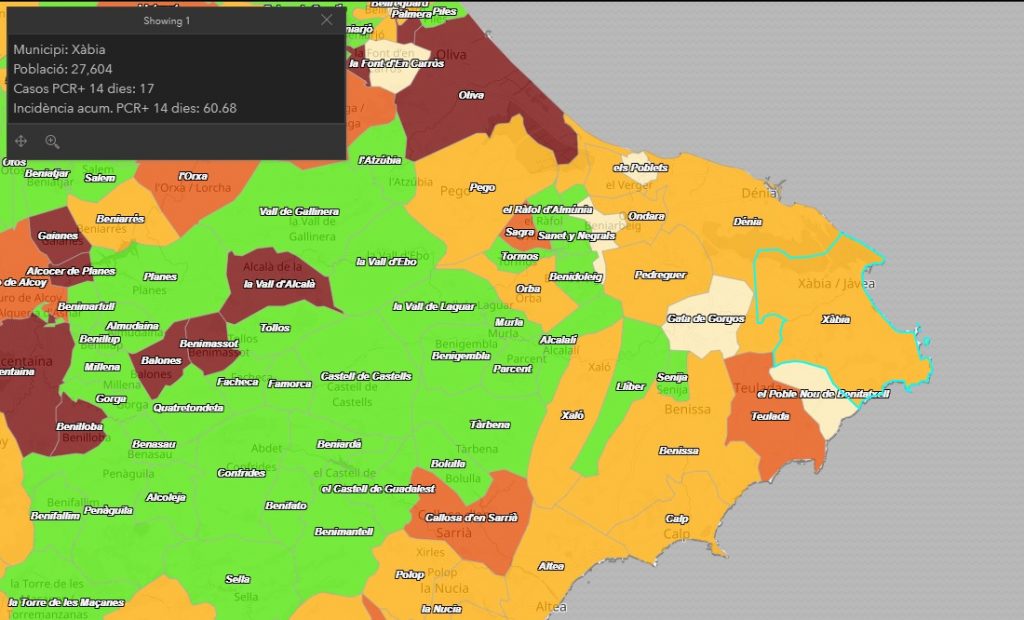
Friday 10th September 2021 – Compiled by MIKE SMITH
Xàbia
The total number of positive coronavirus cases detected by PCR test in Xàbia has climbed to 2,309, according to the latest update from the regional health ministry, an increase of 3 since the last update on Tuesday 7th September.
The municipality’s 14-day IA rate, a measure of the speed at which the virus moves through the population, has dropped to 60.68 cases per 100,000 inhabitants and the town remains into the ‘Medium Risk’ level.

There have been no new deaths in Xàbia since late March and the number remains at 12.
Marina Alta
There have been 160 new positive cases detected by PCR test in the Marina Alta in the past 14 days and the region’s 14-day IA rate has dropped to 122.49 cases per 100,000 inhabitants and it remains into the ‘Medium Risk’ level.
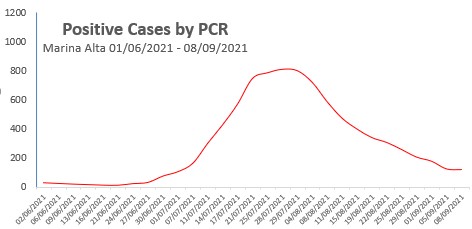
There has been 2 new deaths since the last update – in Dénia and Teulada-Moraira – and the region’s toll rises to 209.
The total number of positive cases since the pandemic began is now 14,490 since the last update on Tuesday 7th September, a rise of 44.
- 13 – Dénia
- 5 – Benissa; Calp
- 4 – Teulada-Moraira
- 3 – Pedreguer; Xàbia
- 2 – El Vergel; Gata de Gorgos; Pego; Xaló
- 1 – Els Poblets; Ondara; Sagra
Municipalities at EXTREME RISK level
None.
Municipalities at HIGH RISK level
Sagra; Teulada-Moraira.
Municipalities at MEDIUM RISK level
Benissa; Calp; Dénia; El Vergel; Ondara; Orba; Pedreguer; Pego; Xàbia; Xaló.
Municipalities at LOW RISK level
Beniarbeig; Els Poblets; Gata de Gorgos; el Poble Nou de Benitatxell.
Autonomous Regions at NEW NORMAL level
Adsubia; Alcalalí; Benidoleig; Benigembla; Benimeli; Castell de Castells; Llíber; Murla; Parcent; el Ràfol d’Almúnia; Sanet y Negrals; Senija; Tormos; la Vall d’Ebo; la Vall de Lagaur; la Vall de Gallinera.
Spain
Spain’s 14-day IA rate is 140.43 cases per 100,000 inhabitants, a drop of over 33% in the last week, and which means that the country drops into the Medium Risk level.
The Positivity Rate, the measure of how many coronavirus tests return positive, has dropped to 6.17%. A value of 5% or less indicates that transmission of the virus is more or less under control.
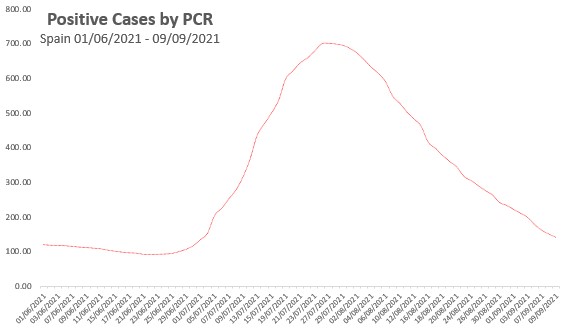
Hospitalizations
According to the latest report from the CCAES, there are 5,115 hospitalized due to COVID-19 across Spain, a drop of over 30% on two weeks ago, of which 1,258 have been admitted to ICU wards, a drop of just over 26% on two weeks ago. The percentage of beds in general wards occupied by patients suffering from COVID-19 is 4.31% whilst the percentage of beds in ICU wards occupied by COVID-19 patients is 13.73%, both lower than two weeks ago.
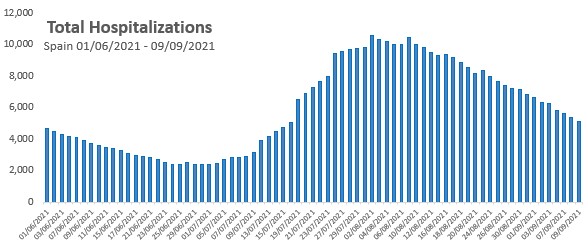
Madrid still leads the way in hospitalizations with 1,080 people currently in hospital due to COVID-19, of which 24.8% have been admitted to ICU wards for extreme cases. Cataluña is just behind, with 1,031 people in hospital, of which 24.01% are in ICU wards, whilst Andalucia has 682 people in hospital, 8.97% of which are being cared for in ICU wards.
In the Comunidad Valenciana, 282 people are currently hospitalized, according to the latest CCAES report, with 8.94% of ICU ward capacity occupied by those suffering from the extreme effects of COVID-19.
Deaths
The country has suffered 270 deaths in the past seven days and the national death toll rises to 85,218 since the pandemic began.
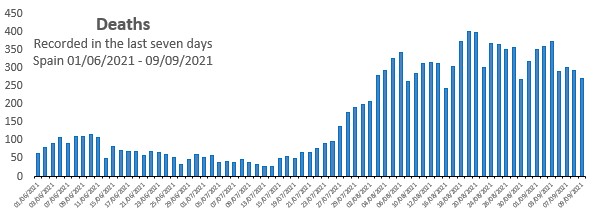
In the Comunidad Valenciana, 31 people have died from the COVID-19 disease in the past seven days, bringing the total to 7,691 since the pandemic began.
Regional Data
Across Spain, the rise of infections continues to slow with all 19 autonomous regions having reported IA rates lower than they were two weeks ago and, on average, they have almost halved since the last week of August.
Only the North African autonomous cities of Melilla (356.01) and Ceuta (267.21) remain at the Extreme Risk level. At the other end of the scale is Asturias (56.83), edging closer to the ‘New Normal’ level, with the Canarias on 93.84
The Comunidad Valenciana’s rate, currently 103.95, has more than halved in the past two weeks and it remains the autonomous region with the second lowest rate in mainland Spain behind Asturias. All health departments in the region has seen positives cases drop over the past two weeks and on average, infection spread has decreased by 53% in the past fortnight.
Autonomous Regions at EXTREME RISK level
Ceuta; Melilla.
Autonomous Regions at HIGH RISK level
Aragón; Baleares; Cantabria; Castilla-La Mancha; Extremadura; La Rioja; Madrid; Navarra; País Vasco
Autonomous Regions at MEDIUM RISK level
Andalucia; Asturias; Canarias; Castilla y León; Cataluña; Comunidad Valenciana; Galicia; Murcia.
Autonomous Regions at LOW RISK level
None
Autonomous Regions at NEW NORMAL level
None
The newspaper El Pais has reported that the return to normal remains uncertain despite falling cases and the advance of the vaccination campaign as students return to school and staff head back to their offices, saying that the next few weeks will be the key to either relaxing measures further or maintaining them to combat new spikes.
How does Spain compare to the rest of Europe?
Top 20 table based on daily new confirmed* COVID-19 cases per 1 million population, based on a 7-day rolling average, recorded on September 9th 2021.
- Montenegro (822.50) ↓
- Serbia (641.50) ↑
- United Kingdom (566.10) ↑
- Kosovo (503.94) ↓
- Slovenia (336.26) ↑
- Switzerland (319.10) ↑
- Albania (303.02) ↓
- Liechtenstein (283.82) ↑
- Lithuania (279.67) ↑
- Republic of Ireland (278.06) ↑
- Estonia (270.37) ↑
- Norway (260.95) ↓
- Turkey (259.77) ↑
- North Macedonia (254.89) ↓
- Cyprus (235.68) ↓
- Greece (218.35) ↓
- Bosnia and Herzegovina (196.59) ↑
- Bulgaria (191.58) ↑
- Austria (188.13) ↑
- Latvia (187.24) ↑
Spain is in the 34th position (96.50) ↓
↑ = infection spread trend rising
↓ = infection spread trend dropping
* The WHO defines a confirmed case is “a person with laboratory confirmation of COVID-19 infection”.
Source: ourworldindata.org
Vaccination (09.09.21)
Spain has administered 68,002,439 doses of vaccine, which is 90.0% of those which it has already received (75,579,701). A total of 34,903,802 people have completed the recommended course, which is 82.9% of the total of the population which is to be vaccinated (42,119,827) or 73.6% of the total population of Spain.
According to the latest data provided by the health authorities, 94.6% of people aged 40 and over in Spain have received at least one dose, with 93.0% having completed the recommended course.
The Comunidad Valenciana has administered 7,342,220 doses of vaccine, which is 91.3% of the total which it has received (8,140,000). A total of 3,779,021 people have completed the recommended course, which 84.2% of the population which is to be vaccinated (4,488,459) or 74.7% of the total population of the Comunidad Valenciana.
According to the latest data provided by the health authorities, 95.1% of people aged 40 and over in the Comunidad Valenciana have received at least one dose, with 93.4% having completed the recommended course.
The newspaper El Pais has reported that some 100,000 people in Spain who have weakened immune systems will receive a third COVID-19 vaccine dose, including organ transplant recipients, bone marrow transplant recipients, and those patients being treated with anti-CD20 drugs.
How does Spain compare to the rest of Europe?
Top 20 table based on percentage of total population fully vaccinated.
- Malta (80.52%)
- Portugal (78.75%)
- Iceland (77.07%)
- Spain (74.32%)
- Denmark (73.45%)
- Belgium (70.73%)
- San Marino (70.51%)
- Republic of Ireland (69.94%)
- United Kingdom (63.95%)
- Netherlands (63.14%)
- Italy (62.92%)
- Norway (62.03%)
- France (61.92%)
- Germany (61.18%)
- Cyprus (59.88%)
- Austria (58.21%)
- Sweden (57.89%)
- Lithuania (57.74%)
- Monaco (57.07%)
- Luxembourg (56.59%)
Source: ourworldindata.org
LINKS
- Actualización nº 459. Enfermedad por el coronavirus (COVID-19). 09.09.2021
- GIV COVID-19 Gestión integral de la vacunación COVID-19
- COVID-19 C. Valenciana: Monitoratge de la situació



